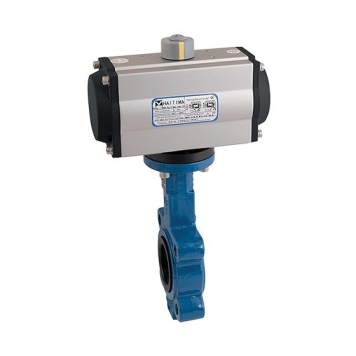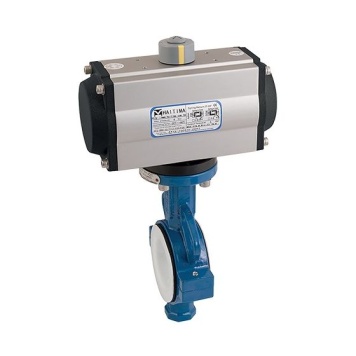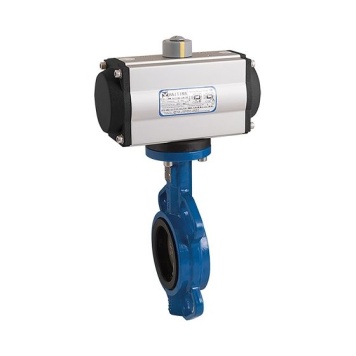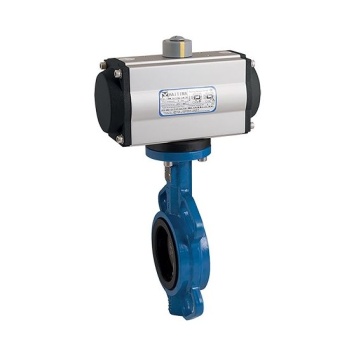Login / Register
- Home
- Actuated Valves
- Pneumatic Actuated Valves
- Pneumatic Actuated Butterfly Valves
Pneumatic Actuated Butterfly Valves
At Pipestock, we provide a versatile range of pneumatic actuated butterfly valves designed for various industrial applications, offering reliable and efficient performance. Our selection includes Ductile Iron Lugged & Tapped Butterfly Valves, Ductile Iron PTFE Wafer Butterfly Valves, Cast Iron Wafer Butterfly Valves, Ductile Iron Wafer Butterfly Valves, and WRAS Approved Butterfly Valves. All our butterfly valves are fitted with the Haitima HTS Pneumatic Actuator, ensuring robust and precise control.
Product Range
- Ductile Iron Lugged & Tapped Butterfly Valve: These valves feature a robust design with lugs for easy installation and removal in pipelines without disturbing adjacent equipment.
- Ductile Iron PTFE Wafer Butterfly Valve: Featuring a PTFE lining, these valves provide excellent chemical resistance, making them ideal for handling aggressive fluids.
- Cast Iron Wafer Butterfly Valve: Known for their durability and cost-effectiveness, cast iron wafer butterfly valves are suitable for a wide range of general industrial applications.
- Ductile Iron Wafer Butterfly Valve: Offering enhanced strength and flexibility, these valves are suitable for applications requiring higher pressure and impact resistance.
- WRAS Approved Butterfly Valves: These valves comply with WRAS standards, making them suitable for potable water applications and ensuring safe and reliable water distribution.
Why Use a Pneumatic Actuator on a Butterfly Valve?
Using a pneumatic actuator on a butterfly valve provides several advantages:
- Fast Operation: Pneumatic actuators offer quick response times, allowing for rapid opening and closing of the valve, which is essential in many industrial processes.
- Simplicity and Reliability: Pneumatic systems are straightforward and robust, with fewer moving parts compared to electric actuators, reducing the likelihood of mechanical failure and minimizing maintenance requirements.
- Explosion Proof: Pneumatic actuators are ideal for hazardous environments where electrical sparks could pose a risk of explosion. They operate using compressed air, making them safe for use in such settings.
- High Force Output: Pneumatic actuators can generate significant force, making them suitable for operating large valves or valves under high pressure.
What Applications Use Pneumatic Actuated Butterfly Valves?
Pneumatic actuated butterfly valves are versatile and used in various applications due to their efficiency and ease of control:
- Domestic Water and Seawater Systems: Valves with EPDM liners are ideal for handling domestic water, seawater, and potable water, ensuring efficient flow control and resistance to environmental conditions.
- HVAC and Cooling Systems: Used in heating, ventilation, and air conditioning systems to regulate the flow of air, water, and steam, and in cooling systems and data centers to ensure optimal temperature control.
- Agricultural and General Process Applications: EPDM lined valves are suitable for agricultural applications and general process control, providing reliable operation in various fluid handling scenarios.
- Wastewater and Oil Handling: NBR lined valves are perfect for managing wastewater, oil, hydrocarbons, and fuel, ensuring durability and resistance to these challenging media.
- High Temperature and Chemical Applications: Valves with Viton (FKM) linings are used in high temperature environments, as well as in handling fuel, oil, and chemicals, due to their superior resistance to heat and aggressive substances.
- Chemical and Pharmaceutical Industries: PTFE lined valves are ideal for managing chemical gases, fluids, and aggressive fluids in chemical processing, petrochemical, pharmaceutical, and food and beverage industries due to their excellent chemical resistance.
What is the Difference Between Cast Iron & Ductile Iron Valves?
- Composition and Properties
- Cast Iron: Composed primarily of iron, carbon, and silicon. It is known for its brittleness and is less resistant to impact and pressure.
- Ductile Iron: Contains additional alloying elements like magnesium, which enhance its ductility and impact resistance. It combines the strength of cast iron with improved flexibility and durability.
- Strength and Flexibility:
- Cast Iron: Suitable for applications with low to moderate pressure and where cost is a significant factor.
- Ductile Iron: Preferred for higher pressure applications and environments requiring greater mechanical strength and resistance to impact.
What is PTFE Lining on a Butterfly Valve?
PTFE (Polytetrafluoroethylene) lining on a butterfly valve provides a high degree of chemical resistance, making it suitable for handling aggressive and corrosive fluids. Key benefits include:
- Chemical Resistance: PTFE is inert to most chemicals, ensuring long-lasting performance in harsh environments.
- Low Friction: PTFE’s low friction coefficient reduces wear and tear on the valve, extending its service life.
- Non-Stick Properties: The non-stick nature of PTFE prevents the buildup of materials on the valve surface, enhancing reliability and reducing maintenance.
What is the Difference Between Lugged & Tapped and Wafer?
- Lugged & Tapped: These valves have threaded inserts (lugs) around the valve body, allowing them to be bolted directly into a pipeline. This design enables the valve to be removed and replaced without affecting the surrounding pipeline, providing easy maintenance and isolation of specific pipeline sections.
- Wafer: Wafer-style butterfly valves are sandwiched between flanges and held in place by long bolts that pass through the flanges and the valve body. This design is more cost-effective and compact, but the entire assembly must be removed for valve maintenance.
If you require any further information, our excellent customer service team is here to help so please call us on 01794 835835.






